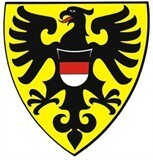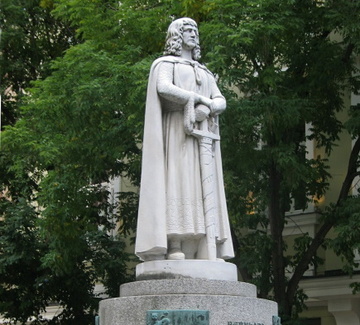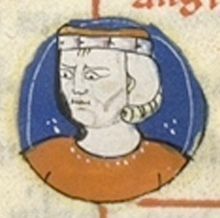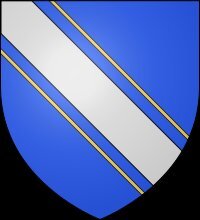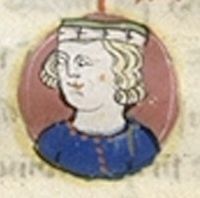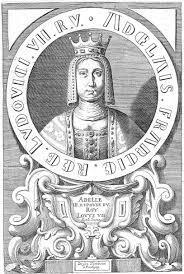maximum test » Mathilde "Mathilde von Kärnten" von Sponheim (1097-1160)
Persoonlijke gegevens Mathilde "Mathilde von Kärnten" von Sponheim
- Roepnaam is Mathilde von Kärnten.
- Zij is geboren in het jaar 1097 in KaerntenCarinthia Austria.
- Gedoopt (op 8-jarige leeftijd of later) door het priesterschapsgezag van de LDS-kerk.
- Alternatief: Gedoopt (op 8-jarige leeftijd of later) door het priesterschapsgezag van de LDS-kerk.
- Alternatief: Gedoopt (op 8-jarige leeftijd of later) door het priesterschapsgezag van de LDS-kerk op 13 juli 1939 in ALBER.
- Beroep: Grevinna.
- Zij is overleden op 13 december 1160 in Fontrevault Abbey, zij was toen 63 jaar oudFontevraud L'Abbaye
Pays de la Loire France. - Zij is begraven in het jaar 1160.
- Een kind van Engelbert von Sponheim en Uta von Passau
- Deze gegevens zijn voor het laatst bijgewerkt op 3 januari 2019.
Gezin van Mathilde "Mathilde von Kärnten" von Sponheim
Zij is getrouwd met Thibault de Blois.
Zij zijn getrouwd rond 1123 te Loir-Et-Cher,CentreBlois
Centre-Val de Loire France.
Kind(eren):
Notities over Mathilde "Mathilde von Kärnten" von Sponheim
GIVN Mathilde (Maude) Princess
SURN Carinthia
REPO @REPO80@
TITL World Family Tree Vol. 11, Ed. 1
AUTH Brøderbund Software, Inc.
PUBL Release date: July 1, 1997
ABBR World Family Tree Vol. 11, Ed. 1
Customer pedigree.
Source Media Type: Family Archive CD
PAGE Tree #3804
DATA
TEXT Date of Import: 18 Dez 1998
REPO @REPO80@
TITL World Family Tree Vol. 11, Ed. 1
AUTH Brøderbund Software, Inc.
PUBL Release date: July 1, 1997
ABBR World Family Tree Vol. 11, Ed. 1
Customer pedigree.
Source Media Type: Family Archive CD
PAGE Tree #3804
DATA
TEXT Date of Import: 18 Dez 1998
REPO @REPO80@
TITL World Family Tree Vol. 11, Ed. 1
AUTH Brøderbund Software, Inc.
PUBL Release date: July 1, 1997
ABBR World Family Tree Vol. 11, Ed. 1
Customer pedigree.
Source Media Type: Family Archive CD
PAGE Tree #3804
DATA
TEXT Date of Import: 18 Dez 1998
DATE 9 SEP 2000
TIME 13:17:33
GIVN Mathilde (Maude) Princess
SURN Carinthia
REPO @REPO80@
TITL World Family Tree Vol. 11, Ed. 1
AUTH Brøderbund Software, Inc.
PUBL Release date: July 1, 1997
ABBR World Family Tree Vol. 11, Ed. 1
Customer pedigree.
Source Media Type: Family Archive CD
PAGE Tree #3804
DATA
TEXT Date of Import: 18 Dez 1998
REPO @REPO80@
TITL World Family Tree Vol. 11, Ed. 1
AUTH Brøderbund Software, Inc.
PUBL Release date: July 1, 1997
ABBR World Family Tree Vol. 11, Ed. 1
Customer pedigree.
Source Media Type: Family Archive CD
PAGE Tree #3804
DATA
TEXT Date of Import: 18 Dez 1998
REPO @REPO80@
TITL World Family Tree Vol. 11, Ed. 1
AUTH Brøderbund Software, Inc.
PUBL Release date: July 1, 1997
ABBR World Family Tree Vol. 11, Ed. 1
Customer pedigree.
Source Media Type: Family Archive CD
PAGE Tree #3804
DATA
TEXT Date of Import: 18 Dez 1998
DATE 9 SEP 2000
TIME 13:17:33
(Research):United Kingdom Encyclopædia Britannica Article History The Normans (1066-1154) The period of anarchy (1135-54) Matilda and Stephen Henry I's death precipitated a 20-year crisis whose immediate cause was a succession dispute. But there has been much debate among historians as to whether the problems of these years were the result of some deeper malaise. No one was enthusiastic about accepting Matilda as queen, especially as her husband, Geoffrey of Anjou, was actually at war with Henry at the time of his death. Robert, Earl of Gloucester, one of Henry's many illegitimate sons, was an impressive candidate for the throne, as were Henry's nephews, Theobald and Stephen of Blois. The outcome of the struggle in 1135 was unexpected: while Theobald, the elder brother, was receiving the homage of continental vassals for Normandy, Stephen took ship for England and claimed the throne. Having secured the treasury at Winchester, he was crowned on December 22. Stephen had been quick and resolute in securing the crown. But after the first flush of victory he made concessions that, instead of winning him support, served to expose his weakness. One such concession was to King David of Scotland, who was also the Earl of Huntingdon in England. When David learned of Stephen's succession, he crossed the border by force. He was effectively bought off by Stephen's agreeing that David's son Henry should receive Carlisle, Doncaster, and the honour of Huntingdon. Stephen obtained the support of Robert of Gloucester by a lavish charter. He also granted a charter to the church forbidding simony and confirmed the rights of church courts to all jurisdiction over clerics. Stephen's lavish appointment of new earls (19 in the course of the reign) was intended in part as a way of undermining the power of the sheriffs and constituted a shift of power away from the centre. Expenditure in Stephen's early years was heavy and achievements few. Stephen soon alienated the church. Much power in central government had been concentrated in the hands of Roger, bishop of Salisbury, and his family. One of Roger's nephews was bishop of Ely, and another was bishop of Lincoln. This was resented by the Beaumont family, headed by the Earl of Leicester, and their allies, who formed a powerful court faction. They planned the downfall of the bishops, and, when a council meeting was held at Oxford in June 1139, they seized on the opportunity provided by a brawl in which some of Roger's men were involved. Rumours of treason were spread, and Stephen demanded that the bishops should make satisfaction. When they did not do so, he ordered their arrest. Thenceforth Stephen was in disfavour with the clergy; he had already forfeited the support of his brother Henry of Blois, bishop of Winchester, by failing to make him archbishop of Canterbury in 1137. As papal legate, Henry was to be the most influential member of the clergy in the realm. Civil war Matilda did not land in England until 1139. She and her half brother Robert of Gloucester established themselves in the southwest; Stephen's main strength lay in the east. In 1141 Stephen was defeated and taken prisoner at the battle of Lincoln, but Matilda alienated the Londoners and lost support. When Stephen was exchanged for Robert of Gloucester, who was captured at Winchester, Matilda's fortunes waned. The Angevin cause, however, prospered in Normandy. Although Matilda's son, Henry, mounted an unsuccessful invasion from Normandy in 1147, in 1153 he carried out a vigorous and effective campaign. Stephen, saddened by the death of his elder son Eustace, agreed to a compromise peace. He was to remain king, but he recognized Henry as his heir. One chronicler said, "In this king's time there was nothing but disturbance and wickedness and robbery." Though this was an exaggeration, it is clear that disorder was widespread, with a great many adulterine castles built (that is, unlicensed castles). It was possible for the earls of Chester and Leicester to make a treaty without any reference to royal authority. Stephen's government lost control of much of England, and power was fragmented and decentralized. There has been much debate as to why men fought in the civil war. It was much more than a simple succession dispute and can be seen as a natural reaction both to the strong, centralized government of Henry I and to the weak rule of Stephen. The aim of many magnates was to recover lands and offices to which they considered they had hereditary rights: much land had changed hands under Henry I. Men such as Ranulf de Gernons, 4th Earl of Chester, and Geoffrey de Mandeville, 1st Earl of Essex, changed sides frequently, obtaining fresh grants each time. Essex wanted to recover the lands and positions his grandfather had held. Most men, however, probably did not want to demolish royal government but rather wished to control and profit from it. The institutions of government did not disappear altogether. The period of the "anarchy" strengthened feudal principles of succession to land, but such offices as those of sheriff and castellan did not become hereditary. History The Normans (1066-1154) England in the Norman period Despite, or perhaps in part because of, the political strains of this period, these were constructive years. The economy, for which Domesday Book is a magnificent source, was essentially agrarian, the main unit being the manor, where the lord's land (or demesne) was worked by unfree peasants who held their land in return for performing labour services. Towns, notably London, flourished, and many received new privileges based on continental practice. The church benefited from closer connections with the Continent in many ways. One such benefit was the arrival of new religious orders: the first Cluniac house was established at Lewes in 1077, and the Cistercians came to England in 1129. A great many Augustinian houses were founded in the first part of the 12th century. Imposing buildings such as Durham Cathedral and the Tower of London give eloquent testimony to the architectural achievement of the Normans, while the illuminated Winchester Bible and Psalter, made for Henry of Blois, bear witness to the artistic excellence of the age. The early Plantagenets Henry II (1154-89) Matilda's son Henry Plantagenet, the first and greatest of three Angevin kings of England, succeeded Stephen in 1154. Aged 21, he already possessed a reputation for restless energy and decisive action. He was to inherit vast lands. As heir to his mother and to Stephen he held England and Normandy; as heir to his father he held Anjou (hence Angevin), Maine, and Touraine; as heir to his brother Geoffrey he obtained Brittany; as husband of Eleanor, the divorced wife of Louis VII of France, he held Aquitaine, the major part of southwestern France. Altogether his holdings in France were far larger than those of the French king. They have become known as the Angevin empire, although Henry never in fact claimed any imperial rights or used the title of emperor. From the beginning Henry showed himself determined to assert and maintain his rights in all his lands. In England this meant reasserting the centralized power of his grandfather, Henry I. His success in these aims is the measure of his greatness. United Kingdom Encyclopædia Britannica Article History The early Plantagenets Henry II (1154-89) Government of England In the first decade of his reign Henry was largely concerned with continental affairs, though he made sure that the adulterine castles in England were destroyed. Many of the earldoms created in the anarchy of Stephen's reign were allowed to lapse. Major change in England began in the mid-1160s. The Assize of Clarendon of 1166, and that of Northampton 10 years later, promoted public order. Juries were used to provide evidence of what crimes had been committed and to bring accusations. New forms of legal action were introduced, notably the so-called possessory assizes, which determined who had the right to immediate possession of land, not who had the best fundamental right. That could be decided by the grand assize, by means of which a jury of 12 knights would decide the case. The use of standardized forms of writ greatly simplified judicial administration. "Returnable" writs, which had to be sent back by the sheriffs to the central administration, enabled the crown to check that its instructions were obeyed. An increasing number of cases came before royal courts rather than private feudal courts. Henry I's practice of sending out itinerant justices was extended and systematized. In 1170 a major inquiry into local administration, the Inquest of Sheriffs, was held, and many sheriffs were dismissed. There were important changes to the military system. In 1166 the tenants in chief were commanded to disclose the number of knights enfeoffed on their lands so that Henry could take proper financial advantage of changes that had taken place since his grandfather's day. Scutage (money payment in lieu of military service) was an important source of funds, and Henry preferred scutage to service because mercenaries were more efficient than feudal contingents. In the Assize of Arms of 1181 Henry determined the arms and equipment appropriate to every free man, based on his income from land. This measure, which could be seen as a revival of the principles of the Anglo-Saxon fyrd, was intended to provide for a local militia, which could be used against invasion, rebellion, or for peacekeeping. Struggle with Thomas Becket Henry attempted to restore the close relationship between church and state that had existed under the Norman kings. His first move was the appointment in 1162 of Thomas Becket as archbishop of Canterbury. Henry assumed that Becket, who had served efficiently as chancellor since 1155 and been a close companion to him, would continue to do so as archbishop. Becket, however, disappointed him. Once appointed archbishop, he became a militant defender of the church against royal encroachment and a champion of the papal ideology of ecclesiastical supremacy over the lay world. The struggle between Henry and Becket reached a crisis at the Council of Clarendon in 1164. In the Constitutions of Clarendon Henry tried to set down in writing the ancient customs of the land. The most controversial issue proved to be that of jurisdiction over "criminous clerks" (clerics who had committed crimes); the king demanded that such men should, after trial in church courts, be sent for punishment in royal courts. Becket initially accepted the Constitutions but would not set his seal to them. Shortly thereafter, however, he suspended himself from office for the sin of yielding to the royal will in the matter. Although he failed to obtain full papal support at this stage, Alexander III ultimately came to his aid over the Constitutions. Later in 1164 Becket was charged with peculation of royal funds when chancellor. After Becket had taken flight for France, the king confiscated the revenues of his province, exiled his friends, and confiscated their revenues. In 1170 Henry had his eldest son crowned king by the archbishop of York, not Canterbury, as was traditional. Becket, in exile, appealed to Rome and excommunicated the clergy who had taken part in the ceremony. A reconciliation between Becket and Henry at the end of the same year settled none of the points at issue. When Becket returned to England, he took further measures against the clergy who had taken part in the coronation. In Normandy the enraged king, hearing the news, burst out with the fateful words that incited four of his knights to take ship for England and murder the archbishop in Canterbury Cathedral. Almost overnight the martyred Thomas became a saint in the eyes of the people. Henry repudiated responsibility for the murder and reconciled himself with the church. But despite various royal promises to abolish customs injurious to the church, royal control of the church was little affected. Henceforth criminous clerks were to be tried in church courts, save for offenses against the forest laws. Disputes over ecclesiastical patronage and church lands that were held on the same terms as lay estates were, however, to come under royal jurisdiction. Finally Henry did penance at Canterbury, allowing the monks to scourge him. But with Becket out of the way, it proved possible to negotiate most of the points at issue between church and state. The martyred archbishop, however, was to prove a potent example for future prelates.
Name Suffix:Of Carinthia
[Norvell.FTW]
[Nix.FTW]
[Nixon.ftw]
She was a member of the dynasty which is now called "Sponheimer" and which survives in (for example) the Princes of Sayn and the Counts of Ortenburg. She was a daughter of Engelbert II (d. 1141), Duke of Carinthia from 1090, and his wife Uta of Passau. See the Schwennicke revision of *Europaeische Stammtafeln*, Band IV, Tafel 118.
[Norvell.FTW]
[Nix.FTW]
[Nixon.ftw]
She was a member of the dynasty which is now called "Sponheimer" and which survives in (for example) the Princes of Sayn and the Counts of Ortenburg. She was a daughter of Engelbert II (d. 1141), Duke of Carinthia from 1090, and his wife Uta of Passau. See the Schwennicke revision of *Europaeische Stammtafeln*, Band IV, Tafel 118.
[alfred_descendants10gen_fromrootsweb_bartont.FTW]
wife of THEOBALD IV; mother of ALIX DE CHAMPAGNE.
SURN Carinthia
GIVN Mathilde Princess
AFN 9HM3-22
_UID 0A4BD7314EF157489165AA2BF2AA8E033338
1 UID 6057D439EE199C46AA020EA5EDA88B628E6E
1 UID 8386CAAE5EEFEF408FDBF4C066041B802076
DATE 21 May 2009
TIME 19:23:43
GIVN Mathilde (Maude) Princess
SURN Carinthia
REPO @REPO80@
TITL World Family Tree Vol. 11, Ed. 1
AUTH Brøderbund Software, Inc.
PUBL Release date: July 1, 1997
ABBR World Family Tree Vol. 11, Ed. 1
Customer pedigree.
Source Media Type: Family Archive CD
PAGE Tree #3804
DATA
TEXT Date of Import: 18 Dez 1998
REPO @REPO80@
TITL World Family Tree Vol. 11, Ed. 1
AUTH Brøderbund Software, Inc.
PUBL Release date: July 1, 1997
ABBR World Family Tree Vol. 11, Ed. 1
Customer pedigree.
Source Media Type: Family Archive CD
PAGE Tree #3804
DATA
TEXT Date of Import: 18 Dez 1998
REPO @REPO80@
TITL World Family Tree Vol. 11, Ed. 1
AUTH Brøderbund Software, Inc.
PUBL Release date: July 1, 1997
ABBR World Family Tree Vol. 11, Ed. 1
Customer pedigree.
Source Media Type: Family Archive CD
PAGE Tree #3804
DATA
TEXT Date of Import: 18 Dez 1998
DATE 9 SEP 2000
TIME 13:17:33
#Générale#de Sponheim
s:HR
{geni:about_me} Matilda of Carinthia was the daughter of Engelbert, Duke of Carinthia and his wife Uta of Passau (Ulric of Passau's daughter). She was married to Theobald II, Count of Champagne (also known as Theobald IV of Blois). She was the mother of Adele of Champagne, Queen consort of France and thus the maternal grandmother of King Philip II of France.
Her children with Theobald included:
Henry I of Champagne
Theobald V of Blois
Adèle of Champagne, Queen consort of France. Wife of Louis VII of France
Isabelle of Champagne, wife of Roger of Apulia and later of William Gouet IV
Marie of Champagne, wife of Eudes II, Duke of Burgundy and later Abbess of Fontevrault
William White Hands, Archbishop of Reims
Stephen I of Sancerre
Agnes of Champagne, wife of Renaut II of Bar
Margaret of Champagne, nun at Fontevrault
--------------------
http://en.wikipedia.org/wiki/Matilda_of_Carinthia
--------------------
Matilda of Carinthia was the daughter of Engelbert, Duke of Carinthia and his wife Uta of Passau (Ulric of Passau's daughter). She was married to Theobald II, Count of Champagne (also known as Theobald IV of Blois). She was the mother of Adele of Champagne, Queen consort of France and thus the maternal grandmother of King Philip II of France.
Her children with Theobald included:
Henry I of Champagne
Theobald V of Blois
Adèle of Champagne, Queen consort of France. Wife of Louis VII of France
Isabelle of Champagne, wife of Roger of Apulia and later of William Gouet IV
Marie of Champagne, wife of Eudes II, Duke of Burgundy and later Abbess of Fontevrault
William White Hands, Archbishop of Reims
Stephen I of Sancerre
Agnes of Champagne, wife of Renaut II of Bar
Margaret of Champagne, nun at Fontevrault
This biographical article of a European noble is a stub. You can help Wikipedia by expanding it.
v • d • e
This European history-related article is a stub. You can help Wikipedia by expanding it.
v • d • e
Retrieved from "http://en.wikipedia.org/wiki/Matilda_of_Carinthia"
Categories: European nobility stubs | European history stubs
--------------------
http://en.wikipedia.org/wiki/Matilda_of_Carinthia
Matilda of Carinthia
From Wikipedia, the free encyclopedia
Jump to: navigation, search
Matilda of Carinthia was the daughter of Engelbert, Duke of Carinthia and his wife Uta of Passau (Ulric of Passau's daughter). She was married to Theobald II, Count of Champagne (also known as Theobald IV of Blois). She was the mother of Adele of Champagne, Queen consort of France and thus the maternal grandmother of King Philip II of France.
Her children with Theobald included:
* Henry I of Champagne
* Theobald V of Blois
* Adèle of Champagne, Queen consort of France. Wife of Louis VII of France
* Isabelle of Champagne, wife of Roger of Apulia and later of William Gouet IV
* Marie of Champagne, wife of Eudes II, Duke of Burgundy and later Abbess of Fontevrault
* William White Hands, Archbishop of Reims
* Stephen I of Sancerre
* Agnes of Champagne, wife of Renaut II of Bar
* Margaret of Champagne, nun at Fontevrault
This page was last modified on 19 March 2009 at 19:29.
--------------------
Matilda of Carinthia
From Wikipedia, the free encyclopedia
Jump to: navigation, search
Matilda of Carinthia was the daughter of Engelbert, Duke of Carinthia and his wife Uta of Passau (Ulric of Passau's daughter). She was married to Theobald II, Count of Champagne (also known as Theobald IV of Blois). She was the mother of Adele of Champagne, Queen consort of France and thus the maternal grandmother of King Philip II of France.
Her children with Theobald included:
* Henry I of Champagne
* Theobald V of Blois
* Adèle of Champagne, Queen consort of France. Wife of Louis VII of France
* Isabelle of Champagne, wife of Roger of Apulia and later of William Gouet IV
* Marie of Champagne, wife of Eudes II, Duke of Burgundy and later Abbess of Fontevrault
* William White Hands, Archbishop of Reims
* Stephen I of Sancerre
* Agnes of Champagne, wife of Renaut II of Bar
* Margaret of Champagne, nun at Fontevrault
This biography of a European noble is a stub. You can help Wikipedia by expanding it.
This European history-related article is a stub. You can help by expanding it.
--------------------
Matilda of Carinthia was the daughter of Engelbert, Duke of Carinthia and his wife Uta of Passau (Ulric of Passau's daughter). She was married to Theobald II, Count of Champagne (also known as Theobald IV of Blois). She was the mother of Adele of Champagne, Queen consort of France and thus the maternal grandmother of King Philip II of France.
Her children with Theobald included:
Henry I of Champagne
Theobald V of Blois
Adèle of Champagne, Queen consort of France. Wife of Louis VII of France
Isabelle of Champagne, wife of Roger of Apulia and later of William Gouet IV
Marie of Champagne, wife of Eudes II, Duke of Burgundy and later Abbess of Fontevrault
William White Hands, Archbishop of Reims
Stephen I of Sancerre
Agnes of Champagne, wife of Renaut II of Bar
Margaret of Champagne, nun at Fontevrault
--------------------
Matilda of Carinthia was the daughter of Engelbert, Duke of Carinthia and his wife Uta of Passau (Ulric of Passau's daughter). She was married to Theobald II, Count of Champagne (also known as Theobald IV of Blois). She was the mother of Adele of Champagne, Queen consort of France and thus the maternal grandmother of King Philip II of France.
Her children with Theobald included:
Henry I of Champagne
Theobald V of Blois
Adèle of Champagne, Queen consort of France. Wife of Louis VII of France
Isabelle of Champagne, wife of Roger of Apulia and later of William Gouet IV
Marie of Champagne, wife of Eudes II, Duke of Burgundy and later Abbess of Fontevrault
William White Hands, Archbishop of Reims
Stephen I of Sancerre
Agnes of Champagne, wife of Renaut II of Bar
Margaret of Champagne, nun at Fontevrault
--------------------
Matilda of Carinthia was was married to Theobald II, Count of Champagne (also known as Theobald IV of Blois).
--------------------
Matilda of Carinthia
From Wikipedia, the free encyclopedia
Matilda of Carinthia was the daughter of Engelbert, Duke of Carinthia and his wife Uta of Passau (Ulric of Passau's daughter). She was married to Theobald II, Count of Champagne (also known as Theobald IV of Blois). She was the mother of Adele of Champagne, Queen consort of France and thus the maternal grandmother of King Philip II of France.
Her children with Theobald included:
Henry I of Champagne
Theobald V of Blois
Adèle of Champagne, Queen consort of France. Wife of Louis VII of France
Isabelle of Champagne, wife of Roger of Apulia and later of William Gouet IV
Marie of Champagne, wife of Eudes II, Duke of Burgundy and later Abbess of Fontevrault
William White Hands, Archbishop of Reims
Stephen I of Sancerre
Agnes of Champagne, wife of Renaut II of Bar
Margaret of Champagne, nun at Fontevrault
--------------------
'''MATHILDE von Sponheim'''
From Medlands
(-[13 Dec 1160/1161]). She is named by Orderic Vitalis, who calls her father "Duke Engelbert", when recording her marriage[125]. The Chronicle of Alberic de Trois-Fontaines names "comitissa Mathildis Campaniensis et uxor Renaldi comitis Nivernensis et comitissa Montis Veteris iuxta Coloniam et mater illorum Romanorum qui Froiepain dicuntur" as sisters of "archiepiscopi Coloniensis Frederici"[126], although the latter is shown by other sources to be their paternal uncle. "Teobaudus Blesensis comes" made a donation to Montiérender by charter dated 1139 with the consent of "Matildis comitissa uxor mee et Henricus filius meus"[127]. "Comitissa Mathildis et filius eius Henricus et Theobaudus et Stephanus" donated property to the abbey of Fontevraud by charter dated to [1125/49][128]. A list of foundations at Troyes records the memory "13 Dec" of "Mathilde épouse du comte Thibaut"[129]. The necrology of Saint-Etienne, Troyes records the death "13 Dec" of "Mathildis comitissa"[130]. The necrology of Chartres cathedral records the death "Id Dec" of "comitissa Mathildis mater…archiepiscopi Senonensis Willelmi et…Henrici comitis, Teobaldi comitis atque comitis Stephani"[131]. m (1123) THIBAUT IV “le Grand/le Vieil” Comte de Blois, son of ETIENNE Comte de Blois & his wife Adela of England ([1085/91]-8 Oct 1152).
--------------------
Matilda of Carinthia was the daughter of Engelbert, Duke of Carinthia and his wife Uta of Passau (Ulric of Passau's daughter). She was married to Theobald II, Count of Champagne (also known as Theobald IV of Blois). She was the mother of Adele of Champagne, Queen consort of France and thus the maternal grandmother of King Philip II of France.
Her children with Theobald included:
Henry I of Champagne
Theobald V of Blois
Adèle of Champagne, Queen consort of France. Wife of Louis VII of France
Isabelle of Champagne, wife of Roger of Apulia and later of William Gouet IV
Marie of Champagne, wife of Eudes II, Duke of Burgundy and later Abbess of Fontevrault
William White Hands, Archbishop of Reims
Stephen I of Sancerre
Agnes of Champagne, wife of Renaut II of Bar
Margaret of Champagne, nun at Fontevrault
--------------------
http://en.wikipedia.org/wiki/Matilda_of_Carinthia
--------------------
Matilda of Carinthia was the daughter of Engelbert, Duke of Carinthia and his wife Uta of Passau (Ulric of Passau's daughter). She was married to Theobald II, Count of Champagne (also known as Theobald IV of Blois). She was the mother of Adele of Champagne, Queen consort of France and thus the maternal grandmother of King Philip II of France.
Her children with Theobald included:
Henry I of Champagne
Theobald V of Blois
Adèle of Champagne, Queen consort of France. Wife of Louis VII of France
Isabelle of Champagne, wife of Roger of Apulia and later of William Gouet IV
Marie of Champagne, wife of Eudes II, Duke of Burgundy and later Abbess of Fontevrault
William White Hands, Archbishop of Reims
Stephen I of Sancerre
Agnes of Champagne, wife of Renaut II of Bar
Margaret of Champagne, nun at Fontevrault
This biographical article of a European noble is a stub. You can help Wikipedia by expanding it.
v • d • e
This European history-related article is a stub. You can help Wikipedia by expanding it.
v • d • e
Retrieved from "http://en.wikipedia.org/wiki/Matilda_of_Carinthia"
Categories: European nobility stubs | European history stubs
--------------------
http://en.wikipedia.org/wiki/Matilda_of_Carinthia
Matilda of Carinthia
From Wikipedia, the free encyclopedia
Jump to: navigation, search
Matilda of Carinthia was the daughter of Engelbert, Duke of Carinthia and his wife Uta of Passau (Ulric of Passau's daughter). She was married to Theobald II, Count of Champagne (also known as Theobald IV of Blois). She was the mother of Adele of Champagne, Queen consort of France and thus the maternal grandmother of King Philip II of France.
Her children with Theobald included:
* Henry I of Champagne
* Theobald V of Blois
* Adèle of Champagne, Queen consort of France. Wife of Louis VII of France
* Isabelle of Champagne, wife of Roger of Apulia and later of William Gouet IV
* Marie of Champagne, wife of Eudes II, Duke of Burgundy and later Abbess of Fontevrault
* William White Hands, Archbishop of Reims
* Stephen I of Sancerre
* Agnes of Champagne, wife of Renaut II of Bar
* Margaret of Champagne, nun at Fontevrault
This page was last modified on 19 March 2009 at 19:29.
--------------------
Matilda of Carinthia
From Wikipedia, the free encyclopedia
Jump to: navigation, search
Matilda of Carinthia was the daughter of Engelbert, Duke of Carinthia and his wife Uta of Passau (Ulric of Passau's daughter). She was married to Theobald II, Count of Champagne (also known as Theobald IV of Blois). She was the mother of Adele of Champagne, Queen consort of France and thus the maternal grandmother of King Philip II of France.
Her children with Theobald included:
* Henry I of Champagne
* Theobald V of Blois
* Adèle of Champagne, Queen consort of France. Wife of Louis VII of France
* Isabelle of Champagne, wife of Roger of Apulia and later of William Gouet IV
* Marie of Champagne, wife of Eudes II, Duke of Burgundy and later Abbess of Fontevrault
* William White Hands, Archbishop of Reims
* Stephen I of Sancerre
* Agnes of Champagne, wife of Renaut II of Bar
* Margaret of Champagne, nun at Fontevrault
This biography of a European noble is a stub. You can help Wikipedia by expanding it.
This European history-related article is a stub. You can help by expanding it.
--------------------
Matilda of Carinthia was the daughter of Engelbert, Duke of Carinthia and his wife Uta of Passau (Ulric of Passau's daughter). She was married to Theobald II, Count of Champagne (also known as Theobald IV of Blois). She was the mother of Adele of Champagne, Queen consort of France and thus the maternal grandmother of King Philip II of France.
Her children with Theobald included:
Henry I of Champagne
Theobald V of Blois
Adèle of Champagne, Queen consort of France. Wife of Louis VII of France
Isabelle of Champagne, wife of Roger of Apulia and later of William Gouet IV
Marie of Champagne, wife of Eudes II, Duke of Burgundy and later Abbess of Fontevrault
William White Hands, Archbishop of Reims
Stephen I of Sancerre
Agnes of Champagne, wife of Renaut II of Bar
Margaret of Champagne, nun at Fontevrault
--------------------
Matilda of Carinthia was the daughter of Engelbert, Duke of Carinthia and his wife Uta of Passau (Ulric of Passau's daughter). She was married to Theobald II, Count of Champagne (also known as Theobald IV of Blois). She was the mother of Adele of Champagne, Queen consort of France and thus the maternal grandmother of King Philip II of France.
Her children with Theobald included:
Henry I of Champagne
Theobald V of Blois
Adèle of Champagne, Queen consort of France. Wife of Louis VII of France
Isabelle of Champagne, wife of Roger of Apulia and later of William Gouet IV
Marie of Champagne, wife of Eudes II, Duke of Burgundy and later Abbess of Fontevrault
William White Hands, Archbishop of Reims
Stephen I of Sancerre
Agnes of Champagne, wife of Renaut II of Bar
Margaret of Champagne, nun at Fontevrault
--------------------
Matilda of Carinthia was was married to Theobald II, Count of Champagne (also known as Theobald IV of Blois).
--------------------
Matilda of Carinthia
From Wikipedia, the free encyclopedia
Matilda of Carinthia was the daughter of Engelbert, Duke of Carinthia and his wife Uta of Passau (Ulric of Passau's daughter). She was married to Theobald II, Count of Champagne (also known as Theobald IV of Blois). She was the mother of Adele of Champagne, Queen consort of France and thus the maternal grandmother of King Philip II of France.
Her children with Theobald included:
Henry I of Champagne
Theobald V of Blois
Adèle of Champagne, Queen consort of France. Wife of Louis VII of France
Isabelle of Champagne, wife of Roger of Apulia and later of William Gouet IV
Marie of Champagne, wife of Eudes II, Duke of Burgundy and later Abbess of Fontevrault
William White Hands, Archbishop of Reims
Stephen I of Sancerre
Agnes of Champagne, wife of Renaut II of Bar
Margaret of Champagne, nun at Fontevrault-------------------- MATHILDE von Sponheim
From Medlands
(-[13 Dec 1160/1161]). She is named by Orderic Vitalis, who calls her father "Duke Engelbert", when recording her marriage[125]. The Chronicle of Alberic de Trois-Fontaines names "comitissa Mathildis Campaniensis et uxor Renaldi comitis Nivernensis et comitissa Montis Veteris iuxta Coloniam et mater illorum Romanorum qui Froiepain dicuntur" as sisters of "archiepiscopi Coloniensis Frederici"[126], although the latter is shown by other sources to be their paternal uncle. "Teobaudus Blesensis comes" made a donation to Montiérender by charter dated 1139 with the consent of "Matildis comitissa uxor mee et Henricus filius meus"[127]. "Comitissa Mathildis et filius eius Henricus et Theobaudus et Stephanus" donated property to the abbey of Fontevraud by charter dated to [1125/49][128]. A list of foundations at Troyes records the memory "13 Dec" of "Mathilde épouse du comte Thibaut"[129]. The necrology of Saint-Etienne, Troyes records the death "13 Dec" of "Mathildis comitissa"[130]. The necrology of Chartres cathedral records the death "Id Dec" of "comitissa Mathildis mater…archiepiscopi Senonensis Willelmi et…Henrici comitis, Teobaldi comitis atque comitis Stephani"[131]. m (1123) THIBAUT IV “le Grand/le Vieil” Comte de Blois, son of ETIENNE Comte de Blois & his wife Adela of England ([1085/91]-8 Oct 1152).
?? Line 2974: (New PAF RIN=10164)
1 NAME Mathilde (Maude) Princess Of /CARINTHIA/
Matilda of Carinthia was the daughter of Engelbert, Duke of Carinthia and his wife Uta of Passau (Ulric of Passau's daughter). She was married to Theobald II, Count of Champagne (also known as Theobald IV of Blois). She was the mother of Adele of Champagne, Queen consort of France and thus the maternal grandmother of King Philip II of France.
Her children with Theobald included:
Henry I of Champagne
Theobald V of Blois
Adèle of Champagne, Queen consort of France. Wife of Louis VII of France
Isabelle of Champagne, wife of Roger of Apulia and later of William Gouet IV
Marie of Champagne, wife of Eudes II, Duke of Burgundy and later Abbess of Fontevrault
William White Hands, Archbishop of Reims
Stephen I of Sancerre
Agnes of Champagne, wife of Renaut II of Bar
Margaret of Champagne, nun at Fontevrault
OR "MAUD""OF CARINTHIA"
Mathilde Carinthia
http://trees.ancestry.com/rd?f=document&guid=29758d0b-560f-4280-9df0-b06c701292b0&tid=8627488&pid=-914565111
Tijdbalk Mathilde "Mathilde von Kärnten" von Sponheim
Deze functionaliteit is alleen beschikbaar voor browsers met Javascript ondersteuning.
Klik op de namen voor meer informatie.
Gebruikte symbolen:  grootouders
grootouders
 ouders
ouders
 broers/zussen
broers/zussen
 kinderen
kinderen
 grootouders
grootouders
 ouders
ouders
 broers/zussen
broers/zussen
 kinderen
kinderen
Voorouders (en nakomelingen) van Mathilde von Sponheim
Mathilde von Sponheim 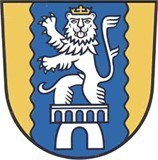 | |||||||||||||||||||||||||||||||||||||
± 1123 | |||||||||||||||||||||||||||||||||||||
Thibault de Blois | |||||||||||||||||||||||||||||||||||||
De getoonde gegevens hebben geen bronnen.
Aanknopingspunten in andere publicaties
Deze persoon komt ook voor in de publicatie:Historische gebeurtenissen
Doopdag 13 juli 1939
- De temperatuur op 13 juli 1939 lag tussen 7,3 °C en 24,1 °C en was gemiddeld 15,8 °C. Er was 10,5 uur zonneschijn (64%). De gemiddelde windsnelheid was 3 Bft (matige wind) en kwam overheersend uit het zuid-zuid-westen. Bron: KNMI
- Koningin Wilhelmina (Huis van Oranje-Nassau) was van 1890 tot 1948 vorst van Nederland (ook wel Koninkrijk der Nederlanden genoemd)
- Van 24 juni 1937 tot 25 juli 1939 was er in Nederland het kabinet Colijn IV met als eerste minister Dr. H. Colijn (ARP).
- Van 25 juli 1939 tot 10 augustus 1939 was er in Nederland het kabinet Colijn V met als eerste minister Dr. H. Colijn (ARP).
- Van 10 augustus 1939 tot 3 september 1940 was er in Nederland het kabinet De Geer II met als eerste minister Jonkheer mr. D.J. de Geer (CHU).
- In het jaar 1939: Bron: Wikipedia
- Nederland had zo'n 8,7 miljoen inwoners.
- 14 maart » Eric Albada Jelgersma, Nederlands ondernemer († 2018)
- 28 maart » Einde Spaanse Burgeroorlog, generaal Francisco Franco verovert Madrid.
- 22 mei » Duitsland en Italië sluiten het Staalpact.
- 18 juli » Opening van het Hallenstadion in Zürich.
- 10 augustus » Het demissionaire kabinet-Colijn V wordt, na slechts 16 dagen geregeerd te hebben, vervangen door kabinet-De Geer II.
- 22 december » Het Reichssicherheitshauptamt (RSHA) wordt opgericht door Heinrich Himmler.
Dezelfde geboorte/sterftedag
- 1124 » Calixtus II (64), paus van Rome
- 1250 » Keizer Frederik II (55), Duits koning en keizer van het Heilige Roomse Rijk
- 1466 » Donatello (80), Italiaans beeldhouwer
- 1521 » Emanuel I van Portugal (52), koning van Portugal
- 1784 » Samuel Johnson (75), Brits essayist, criticus en dichter
- 558 » Childebert I (62), Frankisch koning
Over de familienaam Von Sponheim
- Bekijk de informatie die Genealogie Online heeft over de familienaam Von Sponheim.
- Bekijk de informatie die Open Archieven heeft over Von Sponheim.
- Bekijk in het Wie (onder)zoekt wie? register wie de familienaam Von Sponheim (onder)zoekt.
De publicatie maximum test is opgesteld door Ard van Bergen.
Wilt u bij het overnemen van gegevens uit deze stamboom alstublieft een verwijzing naar de herkomst opnemen:
Ard van Bergen, "maximum test", database, Genealogie Online (https://www.genealogieonline.nl/maximum-test/I6000000001744889539.php : benaderd 1 mei 2024), "Mathilde "Mathilde von Kärnten" von Sponheim (1097-1160)".
Ard van Bergen, "maximum test", database, Genealogie Online (https://www.genealogieonline.nl/maximum-test/I6000000001744889539.php : benaderd 1 mei 2024), "Mathilde "Mathilde von Kärnten" von Sponheim (1097-1160)".

